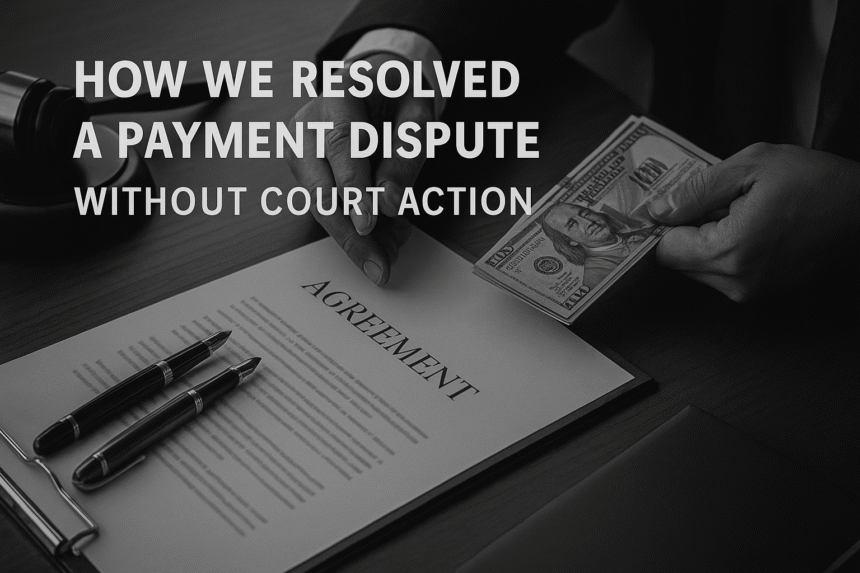How We Resolved a Payment Dispute Without Court Action
When a client refuses to pay for completed work, many businesses panic or head straight for court. But court battles are expensive, time-consuming, and often unnecessary. In this case study, we’ll show how our team resolved a complex payment dispute without litigation, using strategic communication, legal leverage, and a tailored settlement approach.
Quick Summary / Executive Snapshot
- The Problem: A client failed to pay a $47,000 invoice for services rendered under a B2B contract.
- The Strategy: We reviewed the contract, identified pressure points, and issued a firm but non-threatening legal notice.
- The Outcome: The dispute was resolved within three weeks through a negotiated settlement—without going to court.
Background / The Situation
Our client, a regional technology services firm in the Gulf region, had completed a full scope of contracted deliverables for a mid-sized construction company. Despite multiple reminders and confirmation of receipt, the final payment of $47,000 remained unpaid.
The client feared reputational damage if they sued, and wanted to resolve the matter efficiently but firmly.
This matter was critical not just for cash flow—but for signaling to future clients that payment delays would not be tolerated.
The Problem
The dispute involved a signed service agreement, a completed scope of work, and clear evidence that the services had been delivered. However:
- The client delayed payment for over 90 days.
- They claimed internal approval issues and scope disagreement.
- There was no arbitration clause in the contract.
The risk:
- Potential write-off of the full amount.
- Damaged business relationship.
- Costly litigation if escalated.
The Strategy or Solution
Contract Analysis
We began with a detailed review of the contract, looking for:
- Payment timelines and consequences of delay
- Dispute resolution language
- Confirmation of acceptance or silence-as-acceptance clauses
We found:
- A 30-day payment clause with no provision for delays beyond written notice
- Email correspondence confirming service completion
- No formal dispute raised within the allowed period
Legal Notice Drafted Carefully
Instead of threatening court action immediately, we drafted a legal letter that:
- Outlined the facts clearly
- Referenced key contract clauses
- Requested payment within 7 days
- Offered an invitation to resolve the issue amicably
The tone was firm, but respectful. This kept the door open for dialogue.
Strategic Pressure
To encourage resolution, we:
- Informed the client of potential late payment penalties (based on local commercial law)
- Suggested we would be forced to refer to debt recovery services, which would increase the cost for them
- Highlighted the reputational risk of unresolved payment issues in a small industry
Private Settlement Offer
Alongside the letter, we included a conditional offer:
- If paid within 5 working days, we would waive any penalty interest
- If not, legal action or escalation would follow
This saved face for both parties and created a win-win scenario.
The Outcome
- The client responded within 48 hours.
- They requested a 7-day extension, which was granted in writing.
- Full payment was made on the 6th day—before escalation.
The business relationship was preserved, and our client didn’t lose time or money pursuing litigation.
Total resolution time: 21 calendar days.
3 Lessons from This Case
Always include clear payment clauses in your contracts. Ambiguity leads to excuses.
Start with firm communication before threatening legal action. Many disputes resolve with the right tone.
A strategic letter can unlock overdue payments. It shows you mean business without damaging trust.
Final Thoughts + Call-to-Action
This case proves that not every legal conflict needs a courtroom.
When contracts are strong and strategy is clear, most B2B payment disputes can be resolved swiftly and professionally.



Leave a Reply